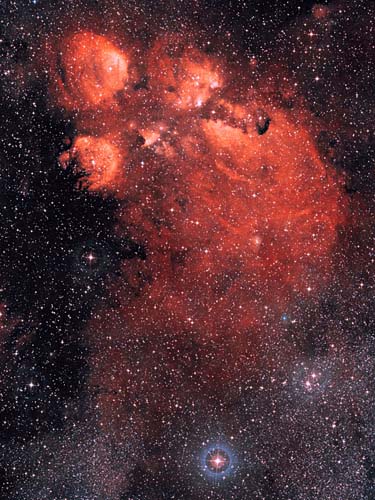Cat's Paw Nebula (NGC 6334)

Cat's Paw Nebula. This composite view was created from images taken with the 2.2-meter MPG/ESO telescope at the La Silla Observatory in Chile, using blue, green and red filters, as well as a filter designed to let through the light of glowing hydrogen.
The Cat's Paw Nebula (NGC 6334), also known as the Bear Claw Nebula, is a large emission
nebula that lies in the constellation Scorpius (near the tip of the scorpion's tail). The whole cloud is about 50 light-years
across. It was discovered by astronomer John Herschel in 1837, who observed it from the Cape of Good Hope.
NGC 6334 is one of the most active nurseries of massive stars in our galaxy
and has been extensively studied by astronomers. The nebula conceals a number
young luminous blue stars – each nearly ten times the mass of our
Sun and born in the last few million years. The region is also home to many
infant stars that are buried deep in the dust, making them difficult to
study. In total, the Cat's Paw Nebula could contain several tens of thousands
of stars.
The nebula is red because its blue and green light are scattered and absorbed more efficiently by material between the nebula and Earth. The red light comes predominantly from hydrogen gas glowing under the intense glare of hot young stars.
| angular size | 40' |
| distance | 5,500 light-years (1,700 pc) |
| position | RA 17h 19m 58s, Dec -35° 57' 47" |
| other designations | ESO 392-EN 009, Sharpless 8, RCW 127, Gum 64 |


